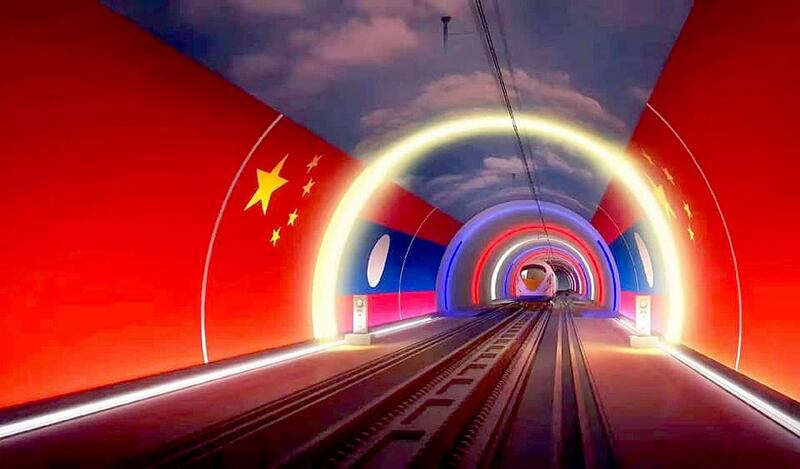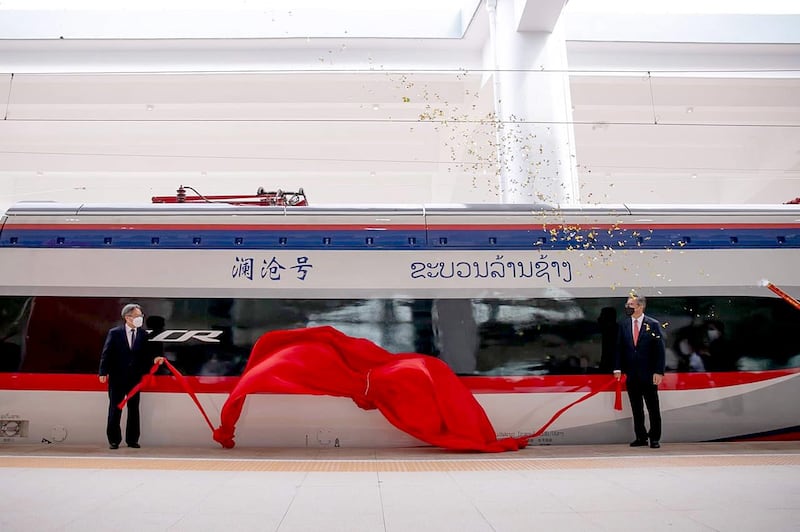The first bullet train to serve the Laos-China high-speed railway was delivered to the Lao capital Vientiane at the weekend, but six weeks before the line is set to open, villagers who lost land to the project say they are still waiting for promised compensation.
The nine-car bullet train capable of carrying 720 passengers was towed to Vientiane and handed over to Viengsavath Siphandone, the Lao minister of public works and transport, by Jiang Zaidong, China's ambassador to Laos.
The U.S. $6 billion railway, whose construction began in December 2016, is part of a longer rail line that will link China to mainland Southeast Asia under Chinese President Xi Jinping’s massive Belt and Road Initiative of infrastructure projects linking nations to China.
The project has been touted as a boon for Laos, an impoverished, landlocked nation of 7 million people, because it is expected to lower the cost of exports and consumer goods, while boosting development and tourism.
China is Laos’ largest foreign investor and aid provider, and its second-largest trade partner after Thailand.
Just six weeks before the route is slated to open in early December, however, villagers who were forced to forfeit land to the project are still waiting for compensation — a problem that has plagued many mega-projects in Laos.
In the Hatxayphong district of Vientiane, nearly 100 families living were promised two years ago they would be paid for their land, and a district official told them they finally would be paid this September, residents told RFA in an earlier report.
At the time, the displaced residents of Dong Phosy and Dong Phonhae villages also complained that the 105,000 kip (U.S. $11) per square meter promised to them for the lost land was below the land’s real value.
Villagers from Hatxayphong district told RFA on Monday that they fear they may never receive the money owed to them.
“We would like to receive the compensation as soon as possible because we’re in the most difficult time right now,” said one resident. “They lied to us. They said they would pay us in September.”
Another resident said that the villagers have not received any official notice from the authorities about their payments.
“We’re not sure whether they’ll pay us or not,” he told RFA. “We’re waiting for it.”
A third villager suggested that if the authorities don’t pay those who had to give up land, then they should give them replacement land equivalent to what they had.
“We just need land to farm and make a living,” he said.
When asked about the compensation, a Hatxayphong district official said he had no further information.
“About the compensation for those who are affected by the railway project, we don’t have any details,” he said. “We haven’t seen any notice from the government.”
Under Lao Decree 84, issued in April 2016, people who lose land to development projects must be compensated for lost income, property, crops, and plants. Project owners are required to guarantee that living conditions for those displaced will be as good as, or better than, they were before the project was started.

Railway to transport mainly goods
Lao Prime Minister Phankham Viphavanh and other officials say the 260-mile Laos section of the railway will start running as scheduled on Dec. 2, but it will be used only to transport cargo until the coronavirus pandemic eases to avoid outbreaks of the virus on the train.
"The train will certainly be operational on Dec. 2, 2021." an official of the Laos Ministry of Public Works and Transport told RFA last week.
"However, the train will used to transport goods first, not passengers yet, because the number of COVID-19 cases is still high, most of the country is still under strict lockdown, and borders are still closed," said the official.
A railway project official told RFA that provincial authorities are urging the central government to open the railway on time.
“Ideally, we would like to see full services including goods and passenger transportation. … Right now, we’re waiting for the order from the central government on when the service for passengers will be ready.”
The owner of a guesthouse in Vang Vieng in Vientiane province said the area is not ready for visitors yet because of the high number of infections in the tourist town, where the district governor has extended a lockdown restricting traffic and travel.
“If there were no COVID-19, of course, we would like the train to be open for passengers as well,” he said. “When that time comes, I’ll have my hotel and restaurant ready for tourists.”
A resident of Luang Prabang, an ancient capital that is the country’s main tourist attraction, agreed.
“I see the authorities are planning the grand opening of the railway, but it will be open only for freight not for passengers because the COVID-19 situation is still dire,” he said. “I hope tourism will resume when the lockdown is lifted. As for now, no travel is allowed.”
In the meantime, Laos is planning to export more agricultural products by train to China, said a Lao agriculture expert.
“Laos is planning to produce more crops for export to China [by train], and more Chinese will come down and invest in agriculture in Laos,” he said. “The concerns are that they [growers] will take over a lot of land and use a lot of chemicals.”
Reported by RFA’s Lao Service. Translated by Max Avary. Written in English by Roseanne Gerin.

